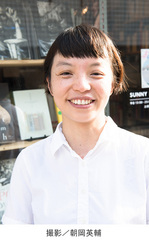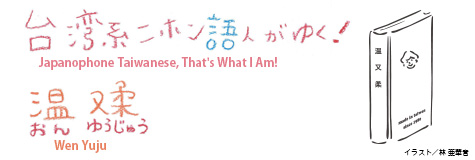
7. Reading The Buddha in the Attic (Part 2)
On June 25, I boarded a plane. It was a domestic flight, so I did not need my passport. Still, I had a feeling of exhilaration at the moment of departure and just before landing. From Fukuoka Airport, I boarded the subway, and as the train car rocked me, I heard the gentle voices of an elderly couple sitting next to me. Fascinated by the intonation slightly different from what I hear in Tokyo, I felt like I could listen to their conversation forever.
I got off the train at Tenjin Station.
My destination was Rethink Books, a brand new bookstore that opened in June (http://rethinkbooks.jp/).
That day, I was going to participate in a talk with translator Yumiko Kotake about The Buddha in the Attic. I was deeply moved by the novel, in which author Julie Otsuka depicts the so-called "picture brides," young Japanese women who traveled by boat to the U.S. at the beginning of the 20th century, using the first-person plural tense. That, however, was not my first encounter with the translation work by Ms. Kotake. I was an avid reader of her translations of the short stories by Alice Munro, and particularly the collection of stories Hateship, Friendship, Courtship, Loveship, Marriage, so for me this event was a source of joy as well as a bit of nervous tension. All in all, it was a rich and rewarding experience.
At the pre-event meeting, Ms. Kotake showed me the cover of The Buddha in the Attic and explained that all those flowers were in fact wild flowers found in Japan. "That's right!" I thought as I pored over each flower, recognizing dandelions, violets, lilies of the valley, and so many more... This discovery lightened my spirit. That was my first meeting with a person I admired immensely, and yet I felt so relaxed and comfortable, undoubtedly because of the warm and inviting personality of Ms. Kotake.
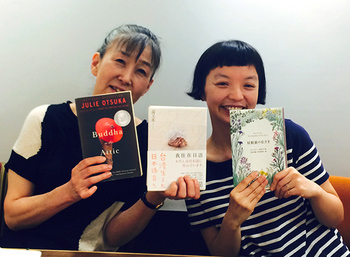
I was deeply moved that Ms. Kotake brought my book Taiwan umare Nihongo sodachi to the meeting. In her right hand, Ms. Kotake is holding the U.S. edition of The Buddha in the Attic.
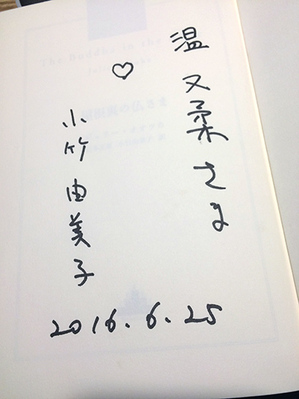
I was very excited to receive her autograph in my copy of The Buddha in the Attic (Shinchosha).
As a reader who was given the opportunity to read The Buddha in the Attic through the wonderful translation of Yumiko Kotake and Masae Iwamoto, I had something I absolutely had to say that day.
In writing the stories of women of the generation of her own grandmother and great-grandmother, author Julie Otsuka had to imagine a world in which a language foreign for her was spoken. As a person who takes in the world, nurtures emotions, relates to people, and thinks exclusively through the English language, she must have perceived Japanese virtually as a foreign language.
"(The children) forgot the names of the flowers in Japanese. They forgot the names of the colors. They forgot the names of the fox god and the thunder god and the god of poverty, whom we could never escape. (...) They forgot the words for snow-light and bell cricket and fleeing in the night. They forgot what to say at the altar to our dead ancestors, who watched over us night and day. They forgot how to count."
(From The Buddha in the Attic)
As an author who wrote in a language in which the numbers 1, 2, 3 were pronounced "one, two, three" instead of "ichi, ni, san," Julie Otsuka had the hard task of expressing phrases, such as snow-light, bell cricket, and fleeing in the night, or Buddhist chants, using only those "twenty-six letters." Yet, these words with their nostalgic ring are not simply a foreign language to the author. Japanese is the language spoken in the "homeland" of her mother, grandmother, and great-grandmother.
"For Julie Otsuka, having her book translated and published in Japan must have been more special than seeing it translated in any other language."
As I was saying this to Ms. Kotake, I was remembering the time one of my novels was translated in Chinese and released in Taiwan.
Also, we could not help touching upon another point of significance that made reading The Buddha in the Attic imperative in Japan more than in any other country in the world.
The closing part of the novel advances towards the saddest and darkest history suffered by Japanese-Americans. "We," the protagonists of the story, are facing the "Last Day."
"Some of us left weeping. And some of us left singing. One of us left with her hand held over her mouth and hysterically laughing. A few of us left drunk. (...) I wanted to visit my home village one last time and burn incense at my father's grave."
(From The Buddha in the Attic)
From the next page begins the last chapter of the book, "A Disappearance." Only in this chapter, "we," the storytellers, become the town people--"the whites," previously referred to as "them"--who voice their thoughts about the "disappeared" Japanese.
"Wouldn't the story have left a stronger impression if the last chapter, too, was narrated by the Japanese women?" I asked boldly.
This question has been with me ever since I first read the novel. In response, Ms. Kotake told me that apparently Julie Otsuka had been pondering a certain question as she wrote the book. That question was "What did the town residents think after the Japanese disappeared?"
Julie Otsuka brings The Buddha in the Attic to a close through the words of the town residents.
"All we know is that the Japanese are out there somewhere, in one place or another, and we shall probably not meet them again in this world."
(From The Buddha in the Attic)
How well do "we" know the cruel destiny that befell the Japanese-Americans in the U.S. during World War II, or, more precisely, after the start of the Pacific War?
Translated into Japanese, Julie Otsuka's novel poses this question to "us," the Japanese readers, as well.
After the event, I had dinner with Ms. Kotake and other members involved in the event at a Japanese izakaya renowned for its delicious sashimi dishes.
The last dish in our modest banquet was a freshly-made rice ball.
Oh, the rice ball of the okāsan's homeland, I thought.
It was served with slices of pickled radish, which was loved by my grandfather.
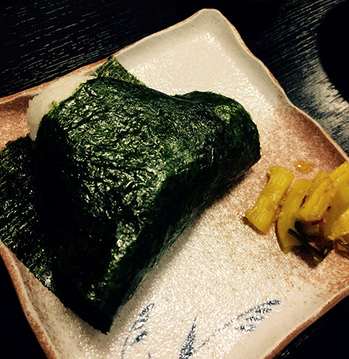
The rice ball and pickled radish that completed our dinner
Suddenly, I realized that the peculiar accent of the elderly couple I heard on the subway reminded me of the Japanese spoken by my grandparents. Perhaps the teacher who taught them at school in the period when Taiwan was under Japanese rule had traveled to the colony from Kyushu.
The next day, I had plenty of time until my plane was scheduled to depart, so I got on a bus to Hakata Wharf. I got off at the last stop and walked to the wharf. It was a sunny clear day. I sat on a bench in the shade of a tree and looked at the ships in the distance.
The Port of Hakata is the largest postwar repatriation port in Japan.
As I looked at the gently-heaving sea, I thought about the people who left from this port, those who returned here, and the nameless people who wanted to return but could not.
...No, that is wrong. There are no nameless people.
The moment I thought this, I felt slightly uneasy.
"Chiyoko, who had always insisted that we call her Charlotte, left insisting that we call her Chiyoko. I've changed my mind one last time."
(From The Buddha in the Attic)
Perhaps Charlotte was not alone. Many of the young women who refused to carry their grandmothers' names replacing them with more American-sounding names must have "changed their minds" on "the last day."
(Did Charlotte know how to write her name in the Chinese characters?)
Fumiko, Iyo, Takako, Haruko... As I remembered the names of the Japanese women in the novel spelled out using those "twenty-six letters," I tried to imagine their Chinese characters.
Perhaps among them there were names given to children born in Taiwan during the final period of the Pacific War, when Taiwan was embroiled in the assimilation policy of Imperial Japan. As I watched in fascination the different shades of blue of the ocean and the sky, I vaguely thought of the women who carried the same names and yet were "out there somewhere, in one place or another," and probably have never met "in this world."
Follow Wen Yuju on Twitter: https://twitter.com/wenyuju
Back Issues
- 2022.7.27 Beyond Disasters - T…
- 2022.6.20 Beyond Disasters - T…
- 2021.6. 7 Contributed Article …
- 2021.4.28 Crossing Borders, En…
- 2021.4.27 Contributed Article …
- 2021.4.20 Contributed Article …
- 2021.3.29 Contributed Article …
- 2020.12.22 Interview with the R…
- 2020.12.21 Interview with the R…
- 2020.11.13 Interview with the R…


